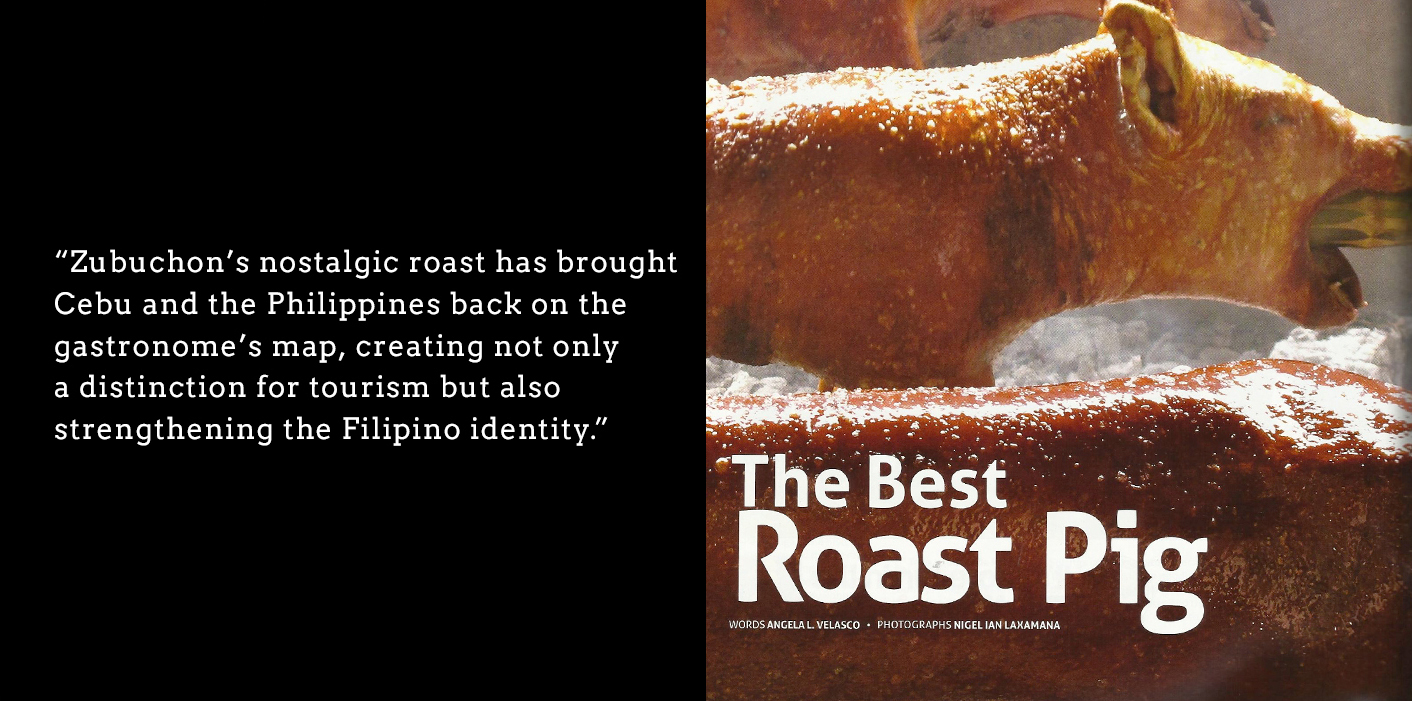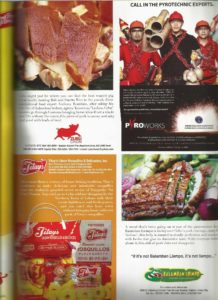THE BEST ROASTED PIG
By Angela L. VelascoCrispy, succulent skin that easily break off the tender roasted mat and savory, smoked pork that can be tasted at whiff of its scent. Whether you're baking chopped pork spices in the oven or roasting the latest kill over charcoal, the draw of roasted meat has captured the world since the domestications of the pig. The Philippines, ever resourceful and open to whatever we can eat, has been feasting on its own variant of roaster pork, lechon, even before the arrival of the Spaniards. Antonio Pigafetta, the Italian scholar who accompanied Ferdinand Magellan upon circumnavigating the world, described in his journals that the locals made a sacrifice of the black pigs "and then roasted them after."
Lechon is more familiar to foreigners and English speakers as suckling pig. Swine was one of the first animals domesticated for human consumption, with the Egyptian, Sumerian, and Roman cultures known to breed them for this purpose. Even during the earlier days of the Roman empire, the elite would feast on the suckling pig and cook it with herbs such as rue, celery, wine, pepper, and coriander seed. This practice carried on to the Middle Ages, with the pig served during weddings. This tradition is kept alive by other countries such as China, where in the suckling pig is an observed custom that represents the bride's purity. The Pacific Islands even require the roast pig as a part of a community or family celebration. Various provinces have attempted to outdo each other in giving its locals and visitors "the best lechon delicacy." From the rows of roasted pigs displayed at the Parada ng Lechon in Balayan, Batangas, the vinegar-dipped pork of Leyte, to the many suppliers competing for the title in Metro Manila, nothing still compared to the "no sauce needed" roast of Cebu.
The pig thrives in an environment that has preserved the Queen of the South's diverse heritage. From centuries-old churches such as the Basilica Minore del Sto. Nino, the country's smallest military defense structure, the Fort San Pedro, to old houses such as the Yap-Sandiego Ancestral Home and Casa Gorrodo Museum, whose families lived since the 17th century, the country's turbulent can be revisited in these structures. Prior to the Spanish occupation, Cebu City's harbor had a reputation among China, Malaysia, Indonesia, and Thailand for being an active trading center. Ceramics, gold, and other luxurious materials were traded among the nations and have been retrieved from deep seas of Bantayan and other nearby islands. One of the oldest districts in Cebu, the Parian dates back to the 16th century as well. Concepcion Briones reminisces about the more romantic time of this area in Life in the Old Parian. As the venue for Chinese traders converge, it eventually became the home of important Cebuano entrepreneurs and residence of affluent families during the start of the 20th century.
Throughout these cultural and structural changes, the roast pork remained a staple. And because of the pork that both local and foreign tourists flock to, the real star of Cebu is its food. One Manila girl who stayed there for less than a year shared that "dining out choices are few since the Cebuanos are very particular about their food and expenses." You have to serve exceptionally made cuisines to catch the locals' attention. Given such a delicious standard, we decided it would be best to narrow down our visit to the search for the Anthony Bourdain, No Reservations host, claimed as the "Best Pig Ever."
In the episode that catapulted Joel's roast and the country to gastronomic fame, Anthony Bourdain challenged the country to this title: "that there are few things I love more than pigs roasted over an open pit," he says leading into the scenes of roasting the pig. "It has been claimed many times that Filipino lechon or whold roasted piggy is the best in the world. I've had a lot of good pigs, so that's a tall order." But as the episode goes on, Bourdain describes the eating experience with sensual and magnificent words: "Look at this magical animal. The skin's extraordinary, it tastes like candy."
Joel Binamira, the man behind the blog Market Manila (marketmanila.com), is responsible for the lechon that caught Bourdain's attention. Hig blog recorded his various roasting adventures and then suddenly a network called to request that they come and visit. "We were asked by chance to be feaures by Mr. Bourdain and when we did if for him, we told him specifically that it was a private affair." His blog is also a popular source for cooking and food enthusiasts, his adventures include scouring the capital city and other provinces for local produce and specialty items from market vendors, farmers, and retailers that "seek out the best the Philippines has to offer,' as described in his About page.
The success of Joel's roast draws from his determination to achieve and provide a good meal. His experiment began with the building of a "lechonan" that houses the charcoal for pig roasting. He tapped the expertise of professional lechon roasters to ensure that he got the entire process right. He then went through five experiments of incorporating local ingredients until his and the staff's taste buds were satisfied. Even the pig's skin went through Joel's own version of acupuncture. What Bourdain referred to as "the best pig ever" was the perfection of these experiments. Instead of gallons of MSG, a four-hour long slow rendering of lard from the pig's stomach is what flavors the roast. "There are no tricks," Joel explains. "We just do it the old-fashioned way." His historical references include Antonio Pigafetta and food columnist, critic and author Doreen Fernandez.
Apart from the freshness of the ingredients and the careful methodology, Zubuchon aims to uphold high quality with the food served. When we had scheduled our visit to the restaurant, General Manager Joan Danao told us to come at a specific time to ensure that the pig we would have was taken off the charcoal. The pigs are roasted early in the morning and then sent off to the different branches late in the morning. Each batch is made within the day and on each day. "What we want to provide is good tasting food at any location." Zubuchon's food is about returning to the delicate and slow processed that result in distinguishable tastes and textures. The lechon redefines this honest form of cooking in particular. There is no need to gnaw through the meat; the pig's meat meshes into the mouth, allowing the pig's natural juices to settle on the tongue.
Ironically, some Cebuanos feel that Joel's roast is not the authentic version. "This is probably cause we throw in rosemary and thyme, tow ingredients that aren't normally there. Also, the skin isn't smooth and we don't paint with soy sauce. Instead, we brush it with coconut water, a practice done 30 of 40 years ago. The coconut water provides a sweetness that can be compared to the 7Up brushed on barbecue," he elaborates. "We make it a point to really undestand how the food is made, without taking any shortcuts." Perhaps, apart from its distinguishable taste, it is this honest return to fresh ingredients and the delicacy of the process that make the roast stand out from the rest of the country's versions. It may not be what some Cebuanos grew up with, but it does bring back practices of our history that today's Filipinos may not be aware of. Joel's "best pig ever" has placed Philippine cuisine on a friendlier plate to foreign tongues. "A lot of foreigners are visiting us," Joel says. "Most of them see Filipino food as something difficult to grasp in such a short period of time. But we're finding that the roast pig is an easy introduction since they have an idea of roast meat."
But Zubuchon's nostalgic roast has brought Cebu and the Philippines back on the gastronome's map, creating not only a distinction for tourism but also for strengthening the Filipino identity. At the same time, foreigners will also have no problem easing into the best pig ever, as the waiters over the Zubuchon are knowledgeable, and suggest either the "purely Filipino" pairing with rice or the more Western combination of salad. And although every Cebuano suggests you let the lechon taste for itself , a plate of vinegar is served for those who want the pork to have that added kick. However you decide to sample Cebu's artery-clogging delight, Zubuchon has retracted history's approach, along with other ingredients that have their home in our islands.





